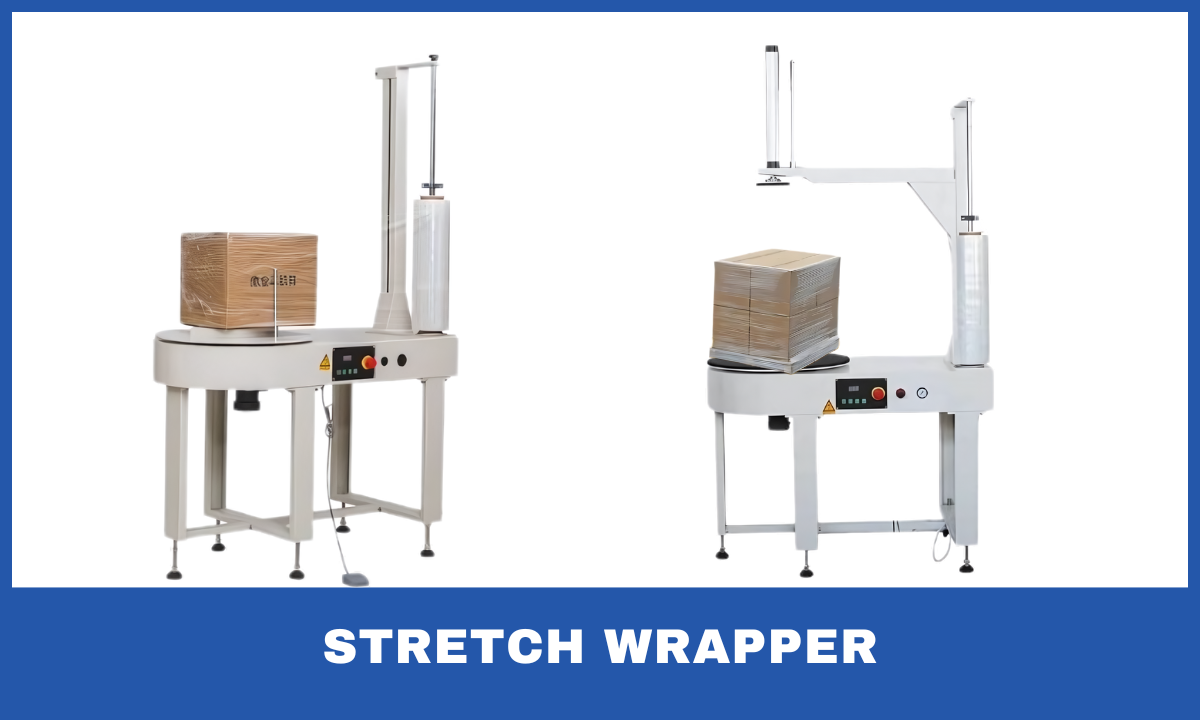
Efficient packaging greatly affects logistics in the company that stores and transports them safe by using stretch wrapper machine. It is not an obstacle for the movement of the big items anymore but at the same time a tool that simplifies the packaging process, and helps to save the time and resources. Our guide will highlight the stretch wrapper machinery and the places they are used in manufacturing. We will let you know the different types of these, what is it, how does it work and where it is most used in industries.
What is a Stretch Wrapper Machine?
A stretch wrapper machine is an automated or semi-automated device that does the stretch film wrapping of items, which is a highly elastic plastic material that is attached to the goods so that they can be kept in good condition, while they are being transported. The process has an added value through minimizing the risk of fractured loads, reducing product damages and improving handling and shipping effectiveness.
Stretch wrapper machines have different forms and options which fit different industries ranging from small business to large scale warehouses. Then, it remains to one of the categories of a pallet wrapper.
Types of Stretch Wrapper Machines
There are numerous stretch wrapper machines. Each type has its specifications and is designed for use for a space and a certain purpose. The most frequently mentioned:
Semi-Automatic Stretch Wrapper: Semi-automatic machinery minimally requires human assistance. The laborer simply wraps the cargo to the pallet and the rest of the work is done by the machine. These machines naturally come with a turntable that is responsible for automatically moving the pallet and allowing the stretch film to be applied. Semi-automatic stretch wrappers are ideal for businesses with average packaging needs.
Fully Automatic Stretch Wrapper: Fully automatic stretch wrappers are all the ones that do not require manual operations to pick the pallets up and to wrap the stretch film around it. These machines automate the tasks of turning the pallet to the machine, attaching the stretch film, and fastening the load without manual intervention. They make work easier in large and intense cases and are good for business in many ways such as efficiency improvement and reduction of labor costs.
How Does a Stretch Wrapper Machine Work?
The working mechanism of a stretch wrapper can change depending on the type, but the basic principles always remain the same. Here's the general working principle of the machines:
Loading the Pallet: The load or pallet is placed on a turntable or positioned in the wrapping area, depending on the type of machine. In a system where that machine uses a turntable or positioning in the wrapping area, the load or pallet is placed on it, depending on the type of machine.
Film Attachment: The operator (in semi-automatic models) attaches the stretch film to the base of the load. In fully automatic systems, the machine takes care of this step. On the other hand, the operator (in semi-automatic models) connects the stretch film to the base of the load. In fully automatic systems, the machine carries out this process.
Wrapping Process: The machine stretches the film as it moves around the pallet. In turntable machines, the pallet rotates while the film is applied. The film is stretched as it wraps, providing tension that tightly secures the load. The machine stretches the film as it moves around the pallet. In turntable machines, the pallet rotates while the film is applied. In rotary arm or orbital wrappers, the wrapping mechanism rotates around the stationary pallet. The film is stretched as it wraps, providing tension that tightly secures the load.
Film Cutting and Sealing: Once the pallet is wrapped, the machine automatically cuts the film and seals the end to ensure that the wrap stays in place. When the pallet is wrapped, the machine automatically cuts the film and seals the end to ensure that the wrap stays in place.
Applications of Stretch Wrapper Machines
Stretch wrapper machines are vital in industries where palletized goods need to be transported or stored. Some common applications include:
Manufacturing: Stretch wrappers are extensively used in manufacturing to secure finished products on pallets for storage and shipping. This helps prevent damage during transportation and improves warehouse organization.
Warehousing and Distribution Centers: In large distribution centers, stretch wrappers are essential for wrapping pallets of goods for shipment. Automatic stretch wrappers, in particular, enhance the speed and efficiency of operations.
Logistics and Freight Forwarding: Stretch wrappers ensure that loads remain stable and intact during long-distance transportation, reducing the risk of damage or shifting during transit. The usage of stretch wrappers significantly guarantees the safety of the packed loads and lowers the scattering, thereby reducing the risk of losses and breakdowns during transit.
Food and Beverage Industry: In the food and beverage sector, stretch wrappers are the ones that are used to pack up large quantities of packed products such as bottled drinks, up to the safe and secure point which is good for the delivery.
E-commerce: Steady growth in e-comm, placing pressure on the supply chain and packaging efficiency.
Pharmaceutical and Chemical Industries: Pharmaceutical and chemical products are packaged in a secure way to avoid contamination and breakage in most cases. The use of such technology, such as stretch wrappers, provides security in handling and transport.
